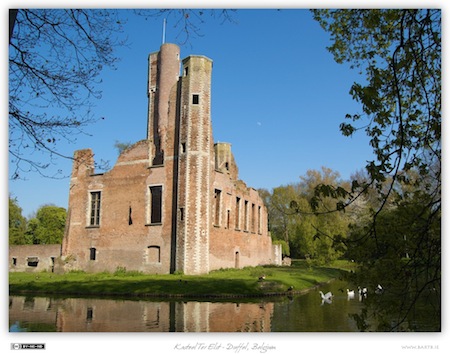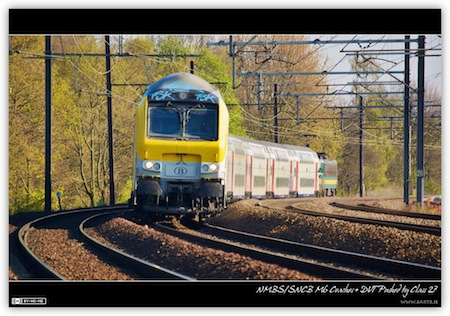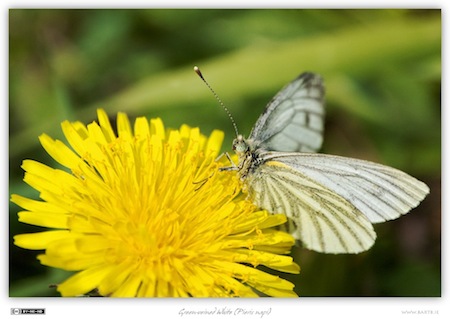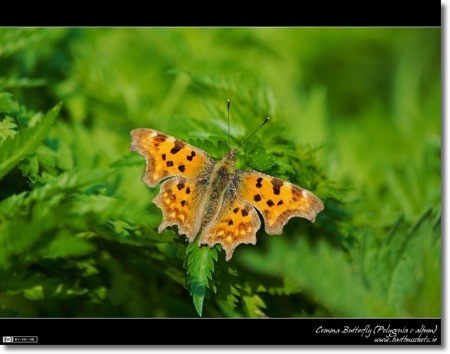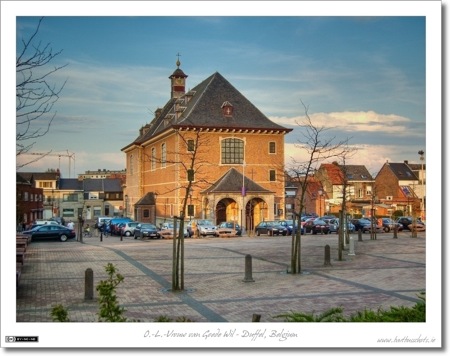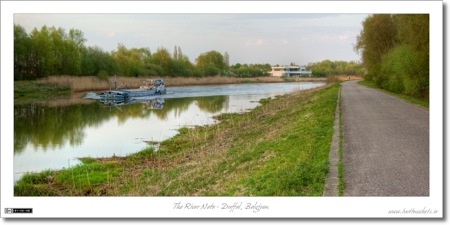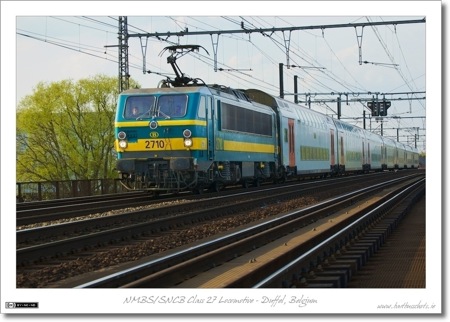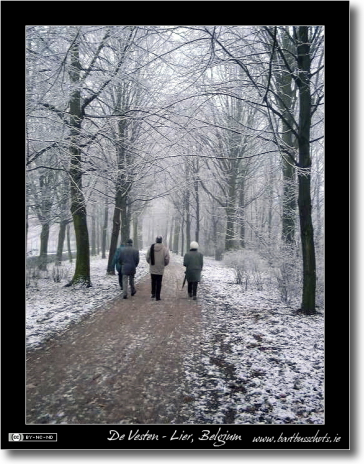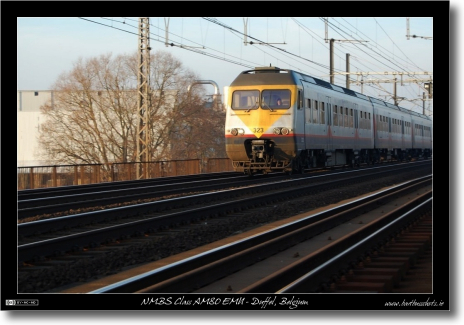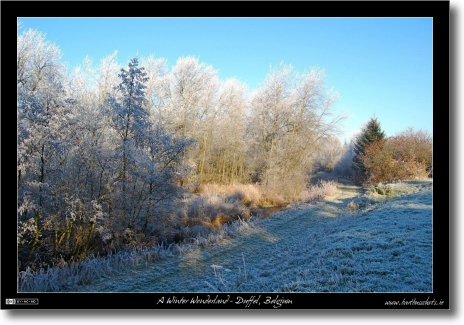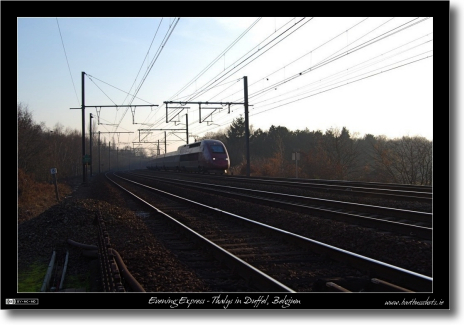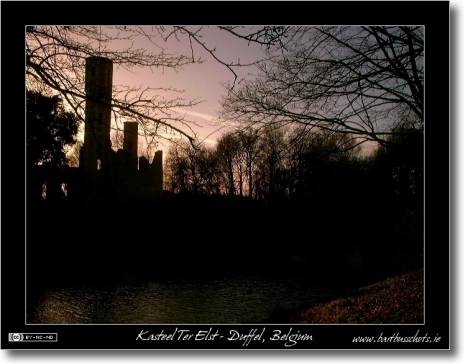May
23
Photo of the Week 116, 117 & 118 – April in Belgium
Filed Under Photography on May 23, 2010 | Leave a Comment
With being sick for the last two weeks I’ve ended up with a triple post this week. I’ve chosen my three favourite shots from my recent trip to Belgium for this instalment’s theme.
The first shot I’ve chosen is of a lovely medeival castle in my home town of Duffel that is locally known as “Kasteel Ter Elst”. It remained intact right up until the first world war when it was unfortunately destroyed. You can read more about the castle here.
- Camera: Nikon D40
- Lens: Nikon DX AFS 18-55mm (D40 kit lens)
- Exposure: 1/400 sec
- Focal Length: 18mm
- Focal Ratio: f/7.1
- ISO: 200
- Camera Mode: Aperture Priority
Perhaps unsurprisingly, the second shot I’ve chosen is a train shot. In this case showing the work-horse combination of the NMBS/SNCB’s intercity services. Here we see a rake of M6 double-decker coaches (with an M6 DVT in front) being pushed by NMBS/SNCB Class 27 electric locomotive number 2725.
- Camera: Nikon D40
- Lens: Nikon DX AFS 55-200mm
- Exposure: 1/640 sec
- Focal Length: 200mm
- Focal Ratio: f/5.6
- ISO: 400
- Camera Mode: Aperture Priority
- Processing Used Topaz Adjust 4 plugin to give the shot a little more ‘pop’.
The final image I’ve chosen is a butterfly shot, specifically a Green-veined White (Pieris napi) feeding on a Dandelion flower (Taraxacum officinale agg.).
- Camera: Nikon D40
- Lens: Nikon DX AFS 55-200mm
- Exposure: 1/1600 sec
- Focal Length: 200mm
- Focal Ratio: f/8
- ISO: 400
- Camera Mode: Aperture Priority
- Processing: Selectively applied the Topaz Adjust 4 plugin to the butterfly and the flower.
Nov
15
Photo of the Week 91 – Comma Butterfly
Filed Under Photography on November 15, 2009 | 1 Comment
This is a shot I took back in April of this year while I was on holidays in Belgium. Common wisdom is that centred subjects are a bad thing in photography, and that they lead to boring photos. Because of that I spent a lot of time trying different crops on this image to come up with a shot where the composition is not centred, but in the end, I didn’t like any of the crops and decided to just ignore common wisdom for this shot. I like how the orange butterfly is surrounded by a see of green, and I think the diagonal orientation of the butterfly makes the composition work despite being centred.
The Comma Butterfly (Polygonia c-album) is exceptionally rare in Ireland. I does show up here from time to time in the very extreme south east in Wexford, but those are individuals who migrate over from the the UK if the summer is very good. In Belgium however, these wonderful butterflies are quite common.
- Camera: Nikon D40
- Lens: Nikon DX AFS 55-200mm
- Exposure: 1/500 sec
- Focal Length: 200mm
- Focal Ratio: f/8
- ISO: 400
- Camera Mode: Aperture Priority
- Processing: the exposure, saturation & contrast were selectively tweaked in the butterfly using Aperture’s Dodge & Burn plugin
Aug
30
Photo of the Week 80 – O.-L.-Vrouw van Goede Wil
Filed Under Photography on August 30, 2009 | Leave a Comment
In some ways this photo is a continuation of an ongoing theme in my recent Photo of the Week instalments – photos shot during the Golden Hour and then tonemapped to bring out the best in them. However, unlike the previous examples, this shot was not taken in Ireland, but rather in my native Belgium.
Although I was baptised into the Catholic Church, we’ve parted ways in the almost 30 yeas that have elapsed since then. However, despite me turning my back on the church (not the ideals of Christianity, just institutionalised Christianity), I still love church Architecture. Churches are usually designed with great care, and are often the most beautiful buildings in a town. This is not just any church though, it’s one of the churches in my home village of Duffel in Belgium, it’s also the church myself and my brothers were baptised in (at least I think all three of us were baptised here). This is not the biggest church in Duffel, but, in my mind, it’s the one with the most character.
The full name of the church is Onze Lieve Vrouw van Goede Wil, but you almost never see it written like that, on paper or signs you’ll generally see it as O.-L.-Vr. van Goede Wil or O.-L.-Vrouw van Goede Wil. In English that roughly translates to Our loving Lady of good will, in other words, it’s a church dedicated to the virgin Mary. Today it’s a small church in a small parish in a small village in the Belgian countryside, but in the past it was a place of pilgrimage. A supposedly miraculous statue of the virgin mother was found in a Willow tree growing in a marshy field where the church now stands.
- Camera: Nikon D40
- Lens: Nikon DX AFS 18-55mm (D40 kit lens)
- Exposure: 1/640 sec
- Focal Length: 32mm
- Focal Ratio: f/4.5
- ISO: 400
- Camera Mode: Aperture Priority
- Processing: Generated by tonemapping a single RAW file in Photomatix Pro and then selectively tweaking the exposure slightly using the Dodge & Burn plugin in Aperture.
May
20
Photo of the Week 65 & 66 – Transportation in Duffel, Belgium
Filed Under Photography on May 20, 2009 | Leave a Comment
Since I’m going to be away next weekend I’m combining this week’s photo of the week with next week’s to give yet another double-installment. As always when I combine two weeks into one, I’ve chosen a theme to unite both shots, in this case, transportation in the Belgian village of Duffel (my birthplace). In some ways these images span centuries. The first is of a heavily laden barge powering down the navigable river that passes through the village, the Nete. The Nete was the best transport link to the village for centuries, if not millennia! The second shows a train on the main line between Brussels and Antwerp which passes through Duffel. This is not the very oldest railway line in continental Europe, but it’s very close, being an extension of the very first one which ran from Brussels to Mechelen. That historic first section of what is now the line form Brussels to Antwerp opened on the 5th of May in 1835, while the remainder of the line, including this section in Duffel, opened a little less than a year later, on the 3rd of May in 1836.
Although Duffel is about 100km from the sea, Belgium is so flat that the Nete is still a tidal river as it passes through Duffel. In fact, at high tide many parts of the village are below the level of the river! For this reason the river is bordered by large dikes on both sides. These dikes are now paved, and serve the local communities as cycle and walking routes. It’s just north of Duffel that the river Nete now connects to the Nete Canal which brings shipping traffic up to the Albert Canal. Because of low bridges and the tidal nature of the river in Duffel, larger boats can only navigate the river at some times of the day, the water being too shallow at low tide, and the bridges too low at high tide. Smaller barges can navigate the river at any time without fear of running aground or crashing into bridges. In this shot we see a barge called Despatch making its way down-stream towards the village of Duffel at the very peak of high tide. As you can see by how low the barge is in the water, she’s clearly fully loaded, probably with coal, sand, or gravel. This kind of barge is low enough to pass under the bridges even at high tide.
- Camera: Nikon D40
- Lens: Nikon DX AFS 18-55mm (D40 kit lens)
- Exposure: 1/320 sec
- Focal Length: 40mm
- Focal Ratio: f/5
- ISO: 400
- Camera Mode: Aperture Priority
- Processing: lightly tonemapped in Photomatic Pro, then the barge was lightened slightly using Aperture’s Dodge & Burn plugin
My second chosen shot is of an evening express service from Antwerp to Brussels crossing the rail bridge over the Nete a little down-stream of Duffel village. This train is making its way along the same track bed that the first train between these two cities ran on way back in 1836. To put that into context, trains have been running here since 60 years after the (US) declaration of Independence. This train is made up of the best coaching stock the NMBS (Belgium’s national railway company, also know as the SNCB) has to offer. These M6 carriages give travellers two decks full of creature comforts on their short and speedy journey between Belgium’s two largest cities. The locomotive pulling the train is an NMBS Class 27 electric locomotive. Although these locomotives are approaching 30 years of age, they are still in fine condition and more than up to the task of whisking passengers between Belgian cities at speeds of up to 160km/h.
- Camera: Nikon D40
- Lens: Nikon DX AFS 18-55mm (D40 kit lens)
- Exposure: 1/500 sec
- Focal Length: 55mm
- Focal Ratio: f/5.6
- ISO: 400
- Camera Mode: Aperture Priority
- Processing: lightened the train a little using Aperture’s Dodge & Burn plugin
Dec
29
Photo of the Week 45 – ‘de Vesten’ in Winter
Filed Under Photography on December 29, 2008 | 1 Comment
When I think of Winter one of my shots stands out above all others, this one in fact. It was also taken at the very end of December, all-be-it back in 2001, so it seemed appropriate for this week’s photo of the week. Unfortunately the photo quality is very poor, which is the main reason I haven’t used it as a photo of the week before. It was shot on a second hand and fairly early digital camera, and the memory card I had for it was far too small, so I used it at a very low quality setting. Because of this the image is small, and has a lot of JPEG artifacting, but I absolutely love it all-the-same.
This shot was taken in the town of Lier, in the province of Antwerp in Belgium. Lier is a very unusual place, it’s absolutely brimming with canals and waterways, a lot like Brugge in fact, but much less well know. Historically it was also an enclosed town, and the remains of that enclosure are what are referred to as ‘de Vesten van Lier’ in Flemish, and it’s on the south eastern region of this enclosure that this photo was taken. The ‘Vesten’ were once the city walls, but they were knocked a few centuries ago and became a long thin park completely surrounding the town.
Lier sits at the point where two important Flemish rivers, the Kleine Nete and the Grote Nete, merge into a single even more important river, the Nete. The two rivers meet at the north of the town, and the joint river snakes around the eastern side of the town. In order to protect the town from flooding, a canal was dug around the western side of the town connecting the Kleine Nete to the Nete, this means the town is completely enclosed by water. On top of this the entire interior of the town is criss-crossed by canals so there is water just about everywhere you look in Lier.
Unfortunately the EXIF data has gotten lost from this file so all I can say is that I shot it with a FujiFilm MX-2700 point-and-shoot.
Nov
30
Photo of the Week 41 – Homeward Bound
Filed Under Photography on November 30, 2008 | 2 Comments
This is one of those photos that I just love but I have no idea why. I’m not even sure it’s actually a good photo, but it’s one of my favourites all the same. What makes my love of it even stranger is that it’s of what I consider to be the ugliest class of train the NMBS (Belgian national rail company) ever brought into service! A real low-point in Belgian train design! Maybe there’s some kind of sub-concious bond because these trains are the same age as me, we both date from 1980.
For those of you interested in such things, here are the technical details of this shot:
- Camera: Nikon D40
- Lens: Nikon DX AFS 18-55mm (D40 kit lens)
- Exposure: 1/160 sec
- Focal Length: 55mm
- Focal Ratio: F6.3
- ISO: 200
- Camera Mode: Auto
Oct
18
Photo of the Week 34 & 35
Filed Under Photography on October 18, 2008 | Leave a Comment
With this double-post I’m finally back on schedule with my photo of the week. Since this is a double-bill I decided to pick a theme, these are my two of my favourite pics shot in my native village of Duffel in Belgium.
The first is a fantastic winter scene that greeted me on the first day of my Christmas holiday in December 2007. When you combine a very thick fog with a very heavy frost followed by a clearance in the morning you get an almost fairy-tale-like scene. I took quite a few shots but this is the one I think worked best.
The second shot is of a Thalys express train passing through Duffel with an international express train from Brussels to Amsterdam. These trains are actually French TGVs in a different coat of paint and are part-owned by the national rail companies of France, Belgium, The Netherlands, and Germany. There are very few places where you can get photos of electric trains without pylons in the way, the rail bridge in Duffel is one of those rare places.
For those of you interested in such things, here are the technical details of the first shot:
- Camera: Nikon D40
- Lens: Nikon DX AFS 18-55mm (D40 kit lens)
- Exposure: 1/320 sec
- Focal Length: 18mm
- Focal Ratio: F5.6
- ISO: 200
- Camera Mode: Aperture Priority
- Exposure Compensation: 0.33
And of the second shot:
- Camera: Nikon D40
- Lens: Nikon DX AFS 18-55mm (D40 kit lens)
- Exposure: 1/250 sec
- Focal Length: 30mm
- Focal Ratio: F8
- ISO: 200
- Camera Mode: Auto
Jul
20
Photo of the Week 22 – Kasteel Ter Elst
Filed Under Photography on July 20, 2008 | Leave a Comment
This is an old photograph. I shot it back in 2001 with an old digital camera so it is small, even at full-size it’s only 640×480 pixels. I held off using it as a photo of the week for ages because of that. However, I’ve decided that size isn’t everything, so here it is!
This shot is a silhouette of the ruins of a once beautiful castle in my native town of Duffel in Belgium. It was shot against a lovely winter sunset. The castle itself dates back to the 12th century and was home to the first recorded lords of Duffel. It now sits in a small pond a few hundred meters away from the river Nete but when it was first built it sat on an island in the river. Obviously it’s not the castle that’s moved since but the course of the river! Like so many things in Belgium it was unfortunately destroyed during WWII. If you’re interested in learning more about the history of the castle check out this page.
For those of you interested in such things here are some of the technical details of the original shot:
- Camera: FujiFilm MX-2700 (point-and-shoot)
- Exposure: 1/400 sec
- Focal Length: 7.6mm
- Focal Ratio: F8
- ISO: 120
- Camera Mode: Auto
- Exposure Compensation: -0.9
[tags]sunset, Belgium, Castle, ruin, Duffel, Belgie, Kasteel, Photography[/tags]







